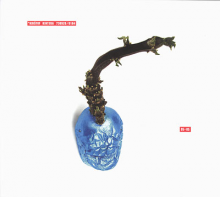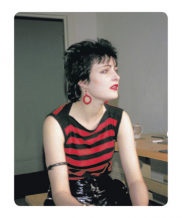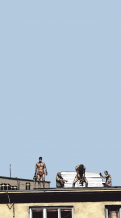| Zeitschrift Umělec 2003/1 >> Martin Piaček scans “kindervajcia” | Übersicht aller Ausgaben | ||||||||||||
|
|||||||||||||
Martin Piaček scans “kindervajcia”Zeitschrift Umělec 2003/101.01.2003 Mira Keratová | profil | en cs |
|||||||||||||
|
"(Kindervajcia are chocolate eggs with toys inside)
MARTIN PIAČEK (1972), graduate of Bratislava VŠVU (University of Fine Arts) (studio of professor J. Bartusz 1994-98 and studio of professor J. Jankovič 1998-2000) is the most controversial artist in the Slovak scene. When in January the periodical 3/4Revue published a poster of naked Piaček, pointing to his genitals, he alone purchased a large majority of the printed copies and later distributed them to the mailboxes of Slovak female art historiographers in an attempt to attract the professional public. On piercing cold winter days he could be seen day after day in pedestrian subways, on street corners, where, next to hoards of Yahweh followers, he offered passers-by the review. He remolded this initiative into the bizarre project HOT SPOTS by offering the above-mentioned periodical first of all to attractive young ladies in exchange for a strange service — they had to show their breasts (legends about several female artists who regularly showed this dandy their breasts have been floating around for years). Nevertheless, a number of young and not so young ladies complied (in the piercing cold). No comment! The whole project has not been made public until now (probably due to financial problems). Martin Piaček is a permanent resident of Bratislava, but does not deny speculations of future departure to Australia (probably surfing and topless girls are to blame). 00 If we try to nail down absolute judgement on Piaček’s works most probably it would be concept. His rational design is made primarily on skepticism towards any intuitive perception; paradoxically, however, when trying to find the alternative system of coordinates we run right into it. Piaček indeed shows a certain tolerance in accepting other points of view, but mostly only as a contribution to more effectively presenting the matter. His trend toward disparagement is rather symptomatic. But in the sense of compliance with principles such as parsimony, physical expression of only the most essential thing — such as support of clear representation of the matter (concept = essence) — Piacek’s opinion appears just as rigorous. After dismantling, his works lose for him their sacred aura, and in most cases he loses it even at the moment of the idea’s inception. 01 Perhaps the most interesting of Piaček’s works are his minimalist space installations, which are mostly inconsiderable interference with already existing spatial arrangements. An example of this trend is 25th hour (1999), in which the artist placed inflated waste bags in discreet places in a real office. This kind of parasitic art ripped the office environment from its everyday stereotype. A more adventurous step is the outdoor work OPIUM ROAD as part of Invisible Exhibition (Pezinok, 1999). The title is indicative. He tossed of poppy seeds on luminous area of covered by sunbeams, disrupting the shadows on the pavement. We could say that he is fascinated by the finitude of the present moment (at the time of the exhibition, for instance) more than by the impressionistic endeavor to appreciate the catching of the passing moment (the position of the sun). The very specific Celulárna Elektroinštalacia s Evou Masarykovou v Galerii Medium, Bratislava (2002) (Cellular Electro Installation with Eva Masarykova in Gallery Medium, Bratislava [2000]) is a minimalist intervention into the gallery space. His intervention concentrates on the entrance and the passages between the separate rooms, where the artists in their individual arrangement installed hot-air pipelines. The installation paradoxically creates an esthetic impression and even formally evoked Judd’s repetitively ordered “primary structures.” However the work is seen as a communication type. The individual rooms of the gallery are separate cells (i.e. basic components of the whole imaginary system). The allegory of the communication between them is the process of material exchange. The guests spread information among the recipients in the different spaces. The active warm zones were created by an artificial amplification of the thermal effect in the space. It was an attempt by the artists to manipulate the spectators’ in an interactive way. The final result was more effective, because a private view of the exhibition was made in the midst of the hot summer. A recent minor demonstration of Piaček’s character was the installation of tapping equipment in the exhibition project Internal Affairs (2003; Buryzone Bratislava, and also in Vienna at the same time) together with Michal Moravčík. The exhibition accentuated a certain political context, as well as privacy against publicity (misuse of recording as an invasion of privacy). The attaching of the special tapping transmitting radio frequency was nearly the only definite artist’s action, besides buying the tapping equipment (bugs) through an advertisement and their installation in the space. 02 Besides the neo-conceptual tendencies, it is also possible to trace pop tendencies in Piaček’s works. He appreciates banality (as a sculptor) and evidently leaves the strategies of classical sculpture personalized by the “struggle with material.” He prefers either a simple interference with ready-made objects or playing with multiplication and appropriation. This position is also represented in his dedicated exhibition cycle Land (2002); Mirbach Palace in Bratislava. He worked there with the still life and with his favorite sexy motifs of wealth, fleshiness and especially the vanities/nothingness (the philosophical element expressed, for example, as a musical instrument, twig, or fly). He created his cycle of still lifes by using thematically selected plastic bags (with the motifs of fruit, vegetable or foodstuffs, still life scenes), which he set in historical gold-leaf frames. Through this he created a fetish of, while enthroning the plastic bags, making his imitation endeavor more delicate. However, he acknowledges plastic bags in various resemblances in individual exhibited pieces. Traces of their wear and tear (abrasion, cracks) simulate the cracked surfaces of old paintings. When the plastic bag is turned inside out, an imaginary geometrical abstraction appears. He used plastic abrasion as the initial ready-made for large-format pictures, completed just by licking and heating lollipops. He transformed an original bust of the 19th century by placing a fly on the neckline and in the ear of the portrayed actress. This approach of humiliating historical material is also emphasized by his placement of the bust in a museum glass showcase. This allusion to museum culture, as well as the fly itself (vanity, death, decay), could be understood as a revocation of the works of Damien Hirst. 03 The starting point for another set of Piaček’s works is the multiplication of castings. This interest in serially multiplied objects shows his affinity for pop art. A theme to which Piaček returns through different variations on a long-term basis — multiplied castings reminiscent of the Buddha in their shape, he opens TEXT No. 1 — book type (1999) and with a close entanglement with the later TEXT No.2 — newspaper type (1999). He responds to the post-modern cult of the text with an expression aided by commodities. He perceives the shape of the Buddha, however, only as a symbol of the universal archetype, which he generalizes. He does not concentrate on the attributes and deprives him of internal/symbolic meaning. The white wall on which the reproductions are placed, substitutes for a sheet of paper. In the first case the work is read by lines from the upper left-hand corner. In the second variation he brings into the work a touch of perturbation and, with the addition of “a female Buddha” — an element of the erotic. The text is read as a newspaper page (a visual rendering works with the layout of the factual newspaper) with their parts having different levels of importance. The multiplication strategy is also presented in the work Trophy (2000). The author works with the possible relation of a boy’s dream and of a trophy, which is presented by the tails and heads of the swordfish embedded in the wall. The illumination of the dark hall with a disco ball creates a surrealistic environment and evokes the impression of a fish shoal floating (in contrast with the actual stiffness of the fishes). One of Piaček’s last projects was ESCAPE (2003) in the Zig-zag centre, Bratislava — Petržalka. Even though it was expressively not about a specific “installation,” the exhibited works belong to this particular place (an empty, white exhibition room in a cultural center in the middle of the biggest Bratislava dwelling area). The author not only nearly maintained the emptiness of the room, but even intensified it. In the first interpretative layer he offered the spectator the anachronism of a quasi-existential condition. He made extra-dimensional enlargements (in this case the human being is no longer the measuring scale for everything) of the push buttons HOME, END, ESC and DELETE presented in the original material, the shape and fonts of letters. He completed all this with the inscription RESET as if scratched by fingernails. He placed the push buttons of the computer keyboard one by one on the walls, above the visitors’ heads. The book by Michel Foucault This is Not a Pipe, displayed in the room, prompts one to follow a further significant level. Foucault here deals with the relationship between imitation and similarity. In this work Piaček reflects only the tension between these two meanings and points out how far a work of art (for example, this one) could be identified at the same time with one as well as the other. 04 Bratislava bohemian life is dull and resembles still water. On top of this, the production of multiplications with no indication of an individual life cannot offer emotions as exciting as the manipulation of one’s own identity. Here it is possible to look for Piaček’s longing to shock and create scandal. In Plagáte-calendar (3/4Revue 14/2002) the author appeared naked and (to make the impression that it was not a cheap sexy photo) on the snapshot he is allegorically stylized into the role of an artist. The thing that soothed his look was his XXL sized penis. This story of Piaček is further developed in the prepared series of works about erotic adventures. Questions for the readers: How big is Martin Piaček’s penis? Has Marek Piaček even got a big penis? Who was Martin with some days ago in Venice? Where will Piaček next erotic adventures of be held? And what does Jiří Ptáček say about it all? "
01.01.2003
Empfohlene Artikel
|
|||||||||||||
|
04.02.2020 10:17
Letošní 50. ročník Art Basel přilákal celkem 93 000 návštěvníků a sběratelů z 80 zemí světa. 290 prémiových galerií představilo umělecká díla od počátku 20. století až po současnost. Hlavní sektor přehlídky, tradičně v prvním patře výstavního prostoru, představil 232 předních galerií z celého světa nabízející umění nejvyšší kvality. Veletrh ukázal vzestupný trend prodeje prostřednictvím galerií jak soukromým sbírkám, tak i institucím. Kromě hlavního veletrhu stály za návštěvu i ty přidružené: Volta, Liste a Photo Basel, k tomu doprovodné programy a výstavy v místních institucích, které kvalitou daleko přesahují hranice města tj. Kunsthalle Basel, Kunstmuseum, Tinguely muzeum nebo Fondation Beyeler.
|




































 New book by I.M.Jirous in English at our online bookshop.
New book by I.M.Jirous in English at our online bookshop.
Kommentar
Der Artikel ist bisher nicht kommentiert wordenNeuen Kommentar einfügen